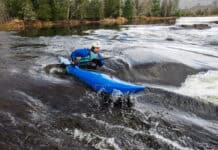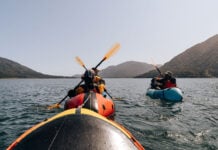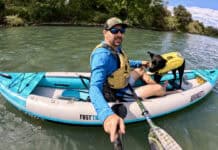My history with 14-foot sea kayaks was inauspicious. Typically, there would be some new iteration to test out for the recreational market. A budget- and beginner-friendly spud with some sea kayak features slapped on: deck lines or a rudder, a rear hatch, a single bulkhead.
P&H Virgo
Length 14 ft 5 in
Width 23 in
Weight 52 lbs
Volume 83 gal
Max paddler weight 220 lbs
MSRP $1,799 USD
As if by some universal formula ruling the length of a kayak must be directly proportional to the anticipated girth and skill of the paddler, the shorter the kayak, the wider and flatter-bottomed it would be. The outfitting would be reliably sloppy, the volume more than ample, the construction suspect. But what else did you really need for picnicking or fishing at the local slough? I’ve paddled and reviewed countless of these short kayaks and tried to temper my expectations and be fair in my appraisals.
So, you can imagine my sentiments when presented with the new Virgo, knowing nothing except that it was a new fourteener. But a few minutes into my first paddle, my first impressions matched what I would have already read in P&H Kayak’s descriptions if I’d done my homework. The Virgo is every bit a serious and bona fide sea kayak, just in a smaller package.
P&H’s intention with the Virgo is to provide “a confidence-inspiring platform that is a real sea kayak and therefore can deal with anything the ocean can throw at you,” sales director Chris Hipgrave told me.
In a blog post about the design, the company loosely relates the Virgo to an updated and souped-up version of the Easky, a recreational 15-footer popular in Europe for many years, or a scaled-down sea kayak offering the performance of the 17-foot P&H Scorpio in a package that’s better sized for weekend trips and easier to get on and off the car. Because “it’s hard to bring the boat weight lower or make transport and storage any easier without losing some length,” according to Hipgrave.
While the Easky was sold at a lower price point under the recreational brand name Venture, the Virgo is under the P&H banner. It has the stiff and light three-layer sandwich CoreLite X plastic and the same outfitting as other P&H plastic sea kayaks. And it’s designed with the same watertight bulkheads, bow and stern waterproof KajakSport hatches, hull strength and full deck lines for rough ocean paddling, rolling and rescues.
Slipping into the cockpit reminded me of whitewater kayaks and play-oriented sea kayaks, like P&H’s 15-foot Delphin. At 23 inches wide, the Virgo retains high-performance sea kayak dimensions—no extra-wide or oversized cockpit here, and a nice low back deck suited for ease of entry, exit and rolling.
P&H’s Connect outfitting provides an instantly comfortable performance fit. There’s enough room for a medium-sized paddler—my 175-pound frame with 34- by 34-inch pant size maxed out the length of the foot braces and fit snugly between the hip pads. Eventually, P&H plans to make the Virgo in three sizes, like its other models. This flagship Virgo will one day become the medium, but at the time of writing, it’s the only option.
The Virgo tracks well for such a short kayak and cruises at a reasonable three or four knots. A moderately steep bow and stern keep the waterline long for speed and tracking, but the line of the hard chine rises up from the waterline to the ends of the boat to give it a sleek and playful look, a mischievous side profile like the Joker’s smile. In calm conditions, I didn’t bother putting the skeg down, just throwing in some correction strokes from time to time to stay on course. For long distances or windy conditions, the skeg would save energy.

Happily, when P&H considered scaling down the sea kayak, they also made it sportier, since speed probably isn’t your primary concern if you’re paddling a 14-footer. You’re more likely to want to have some fun wherever you already are—like at the small beach break I found during my test paddle.
Some hot dogs from the P&H team must’ve got their hands onto the CAD file at some point, predicting they’d be asked to surf it at Skookumchuck for a photoshoot some day. The Virgo has just enough rocker to spin around when you want it to, turning 90 degrees with a couple of strokes on one side. Unlike the Scorpio, which has rounded chines, the Virgo has aggressive rails so you can put it on edge and carve it like a parabolic ski.
The Virgo felt adept when I caught a wave, giving a boost to my confidence and making me feel coordinated on the wave even though I hardly ever surf. The buoyant and flared bow stayed above the wave and kept me dry. Inspired, on the way back to shore, I slipped into the steep wake of a passing tugboat, accelerated and caught a long ride most of the way back to my car.
My only quibbles with the design are minor. I found the forward placement of the skeg control and paddle park—well in front of the paddler’s knees—to be slightly awkward, and the deck bungees overlap the skeg control and the optional mini hatch unless you find a way to reroute them. Used to the speed, tracking and glide of the longer sea kayaks I usually paddle, I felt like if the Virgo were 12 to 18 inches longer it would be the ideal all-rounder. But of course, with that extra length would come the weight and storage challenges the Virgo is intended to avoid—and likely a higher price tag too.
For its size and intended purpose, the Virgo could hardly be more perfect. In the market niche for what P&H calls “a compact, but uncompromising sea kayak for weekend warriors,” the Virgo will surely dominate for years to come.
Serious sea kayaking credibility, now in a smaller package. | Photo: Scott MacGregor








